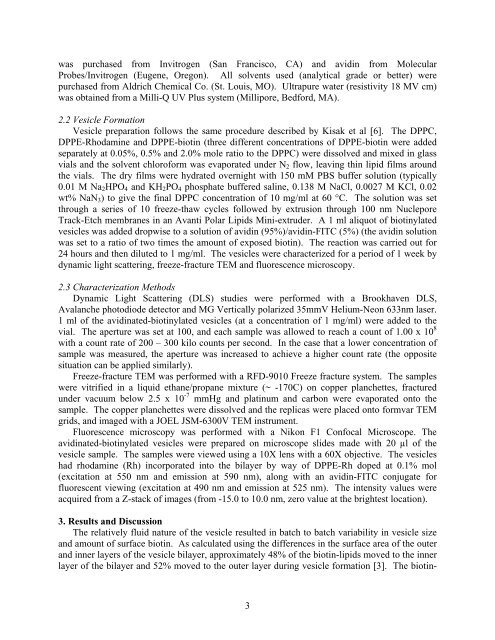The Secret Society: Descendants of Crypto-Jews in the San Antonio ...
The Secret Society: Descendants of Crypto-Jews in the San Antonio ...
The Secret Society: Descendants of Crypto-Jews in the San Antonio ...
Create successful ePaper yourself
Turn your PDF publications into a flip-book with our unique Google optimized e-Paper software.
was purchased from Invitrogen (<strong>San</strong> Francisco, CA) and avid<strong>in</strong> from Molecular<br />
Probes/Invitrogen (Eugene, Oregon). All solvents used (analytical grade or better) were<br />
purchased from Aldrich Chemical Co. (St. Louis, MO). Ultrapure water (resistivity 18 MV cm)<br />
was obta<strong>in</strong>ed from a Milli-Q UV Plus system (Millipore, Bedford, MA).<br />
2.2 Vesicle Formation<br />
Vesicle preparation follows <strong>the</strong> same procedure described by Kisak et al [6]. <strong>The</strong> DPPC,<br />
DPPE-Rhodam<strong>in</strong>e and DPPE-biot<strong>in</strong> (three different concentrations <strong>of</strong> DPPE-biot<strong>in</strong> were added<br />
separately at 0.05%, 0.5% and 2.0% mole ratio to <strong>the</strong> DPPC) were dissolved and mixed <strong>in</strong> glass<br />
vials and <strong>the</strong> solvent chlor<strong>of</strong>orm was evaporated under N 2 flow, leav<strong>in</strong>g th<strong>in</strong> lipid films around<br />
<strong>the</strong> vials. <strong>The</strong> dry films were hydrated overnight with 150 mM PBS buffer solution (typically<br />
0.01 M Na 2 HPO 4 and KH 2 PO 4 phosphate buffered sal<strong>in</strong>e, 0.138 M NaCl, 0.0027 M KCl, 0.02<br />
wt% NaN 3 ) to give <strong>the</strong> f<strong>in</strong>al DPPC concentration <strong>of</strong> 10 mg/ml at 60 °C. <strong>The</strong> solution was set<br />
through a series <strong>of</strong> 10 freeze-thaw cycles followed by extrusion through 100 nm Nuclepore<br />
Track-Etch membranes <strong>in</strong> an Avanti Polar Lipids M<strong>in</strong>i-extruder. A 1 ml aliquot <strong>of</strong> biot<strong>in</strong>ylated<br />
vesicles was added dropwise to a solution <strong>of</strong> avid<strong>in</strong> (95%)/avid<strong>in</strong>-FITC (5%) (<strong>the</strong> avid<strong>in</strong> solution<br />
was set to a ratio <strong>of</strong> two times <strong>the</strong> amount <strong>of</strong> exposed biot<strong>in</strong>). <strong>The</strong> reaction was carried out for<br />
24 hours and <strong>the</strong>n diluted to 1 mg/ml. <strong>The</strong> vesicles were characterized for a period <strong>of</strong> 1 week by<br />
dynamic light scatter<strong>in</strong>g, freeze-fracture TEM and fluorescence microscopy.<br />
2.3 Characterization Methods<br />
Dynamic Light Scatter<strong>in</strong>g (DLS) studies were performed with a Brookhaven DLS,<br />
Avalanche photodiode detector and MG Vertically polarized 35mmV Helium-Neon 633nm laser.<br />
1 ml <strong>of</strong> <strong>the</strong> avid<strong>in</strong>ated-biot<strong>in</strong>ylated vesicles (at a concentration <strong>of</strong> 1 mg/ml) were added to <strong>the</strong><br />
vial. <strong>The</strong> aperture was set at 100, and each sample was allowed to reach a count <strong>of</strong> 1.00 x 10 8<br />
with a count rate <strong>of</strong> 200 – 300 kilo counts per second. In <strong>the</strong> case that a lower concentration <strong>of</strong><br />
sample was measured, <strong>the</strong> aperture was <strong>in</strong>creased to achieve a higher count rate (<strong>the</strong> opposite<br />
situation can be applied similarly).<br />
Freeze-fracture TEM was performed with a RFD-9010 Freeze fracture system. <strong>The</strong> samples<br />
were vitrified <strong>in</strong> a liquid ethane/propane mixture (~ -170C) on copper planchettes, fractured<br />
under vacuum below 2.5 x 10 -7 mmHg and plat<strong>in</strong>um and carbon were evaporated onto <strong>the</strong><br />
sample. <strong>The</strong> copper planchettes were dissolved and <strong>the</strong> replicas were placed onto formvar TEM<br />
grids, and imaged with a JOEL JSM-6300V TEM <strong>in</strong>strument.<br />
Fluorescence microscopy was performed with a Nikon F1 Confocal Microscope. <strong>The</strong><br />
avid<strong>in</strong>ated-biot<strong>in</strong>ylated vesicles were prepared on microscope slides made with 20 µl <strong>of</strong> <strong>the</strong><br />
vesicle sample. <strong>The</strong> samples were viewed us<strong>in</strong>g a 10X lens with a 60X objective. <strong>The</strong> vesicles<br />
had rhodam<strong>in</strong>e (Rh) <strong>in</strong>corporated <strong>in</strong>to <strong>the</strong> bilayer by way <strong>of</strong> DPPE-Rh doped at 0.1% mol<br />
(excitation at 550 nm and emission at 590 nm), along with an avid<strong>in</strong>-FITC conjugate for<br />
fluorescent view<strong>in</strong>g (excitation at 490 nm and emission at 525 nm). <strong>The</strong> <strong>in</strong>tensity values were<br />
acquired from a Z-stack <strong>of</strong> images (from -15.0 to 10.0 nm, zero value at <strong>the</strong> brightest location).<br />
3. Results and Discussion<br />
<strong>The</strong> relatively fluid nature <strong>of</strong> <strong>the</strong> vesicle resulted <strong>in</strong> batch to batch variability <strong>in</strong> vesicle size<br />
and amount <strong>of</strong> surface biot<strong>in</strong>. As calculated us<strong>in</strong>g <strong>the</strong> differences <strong>in</strong> <strong>the</strong> surface area <strong>of</strong> <strong>the</strong> outer<br />
and <strong>in</strong>ner layers <strong>of</strong> <strong>the</strong> vesicle bilayer, approximately 48% <strong>of</strong> <strong>the</strong> biot<strong>in</strong>-lipids moved to <strong>the</strong> <strong>in</strong>ner<br />
layer <strong>of</strong> <strong>the</strong> bilayer and 52% moved to <strong>the</strong> outer layer dur<strong>in</strong>g vesicle formation [3]. <strong>The</strong> biot<strong>in</strong>-<br />
3
















